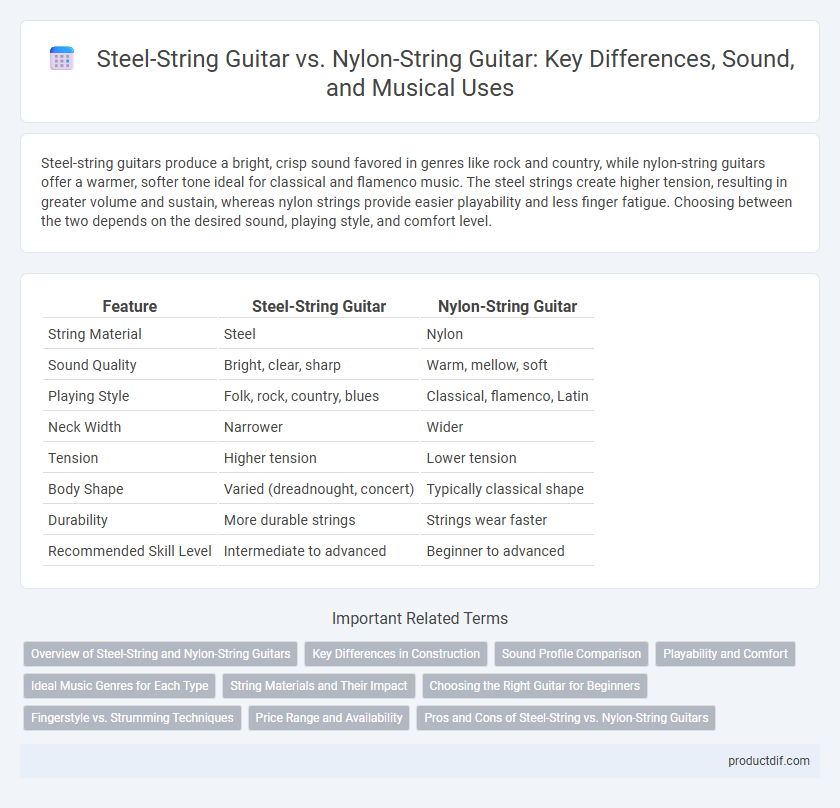Steel-string guitars produce a bright, crisp sound favored in genres like rock and country, while nylon-string guitars offer a warmer, softer tone ideal for classical and flamenco music. The steel strings create higher tension, resulting in greater volume and sustain, whereas nylon strings provide easier playability and less finger fatigue. Choosing between the two depends on the desired sound, playing style, and comfort level.
Table of Comparison
| Feature | Steel-String Guitar | Nylon-String Guitar |
|---|---|---|
| String Material | Steel | Nylon |
| Sound Quality | Bright, clear, sharp | Warm, mellow, soft |
| Playing Style | Folk, rock, country, blues | Classical, flamenco, Latin |
| Neck Width | Narrower | Wider |
| Tension | Higher tension | Lower tension |
| Body Shape | Varied (dreadnought, concert) | Typically classical shape |
| Durability | More durable strings | Strings wear faster |
| Recommended Skill Level | Intermediate to advanced | Beginner to advanced |
Overview of Steel-String and Nylon-String Guitars
Steel-string guitars feature bright, crisp tones favored in genres like rock, country, and folk, with strings made from phosphor bronze or steel alloys that offer strong projection and sustain. Nylon-string guitars, commonly used in classical and flamenco music, produce warm, mellow sounds due to softer nylon strings and wider fingerboards, facilitating fingerstyle playing. Construction differences include steel-string guitars typically having a narrower neck and a reinforced bracing system to withstand higher tension, while nylon-string guitars use lighter bracing and a more delicate build.
Key Differences in Construction
Steel-string guitars feature a reinforced neck and a truss rod to handle higher string tension, whereas nylon-string guitars typically have a wider neck and a flat fingerboard designed for softer, lower-tension nylon strings. The body of steel-string guitars often includes a stronger bracing pattern, such as X-bracing, to withstand the increased tension, while nylon-string guitars use fan bracing to enhance resonance and warmth. Materials also differ, with steel-string guitars commonly using harder woods like spruce or mahogany for the top, contrasting with the cedar or spruce tops favored in nylon-string guitars for their mellower tone.
Sound Profile Comparison
Steel-string guitars produce a bright, crisp tone with pronounced attack and shimmering overtones, making them ideal for genres like rock, country, and folk. Nylon-string guitars offer a warm, mellow sound with softer attack and rich bass response, often preferred in classical, flamenco, and jazz music. The tonal difference arises from string material and tension, influencing projection, sustain, and playing style.
Playability and Comfort
Steel-string guitars offer higher tension strings that produce brighter tones but may require more finger strength, affecting playability and comfort for beginners or those with sensitive fingers. Nylon-string guitars feature softer, more flexible strings that reduce finger fatigue and facilitate smoother chord transitions, enhancing comfort during extended playing sessions. The wider neck of nylon-string guitars also provides ample space for finger placement, improving overall playability for classical and fingerstyle techniques.
Ideal Music Genres for Each Type
Steel-string guitars are ideal for genres such as rock, country, blues, and folk due to their bright, crisp sound and strong projection, which complements strumming and flatpicking styles. Nylon-string guitars excel in classical, flamenco, and bossa nova music, producing warm, mellow tones with softer attack suited for fingerstyle playing. The choice between steel and nylon strings depends largely on the desired tonal quality and stylistic requirements of the music genre.
String Materials and Their Impact
Steel-string guitars use high-tensile steel strings that produce a bright, sharp tone ideal for genres like country and rock, while nylon-string guitars feature softer nylon strings that offer a warm, mellow sound suited for classical and flamenco music. The material differences significantly affect playability; steel strings require higher tension and finger strength, whereas nylon strings are easier on the fingers, making them more accessible for beginners. String composition also impacts durability, with steel strings generally lasting longer but being more prone to corrosion compared to the more flexible yet fragile nylon strings.
Choosing the Right Guitar for Beginners
Steel-string guitars offer a bright, crisp tone and are ideal for genres like rock, folk, and country, making them a popular choice for beginners seeking versatility. Nylon-string guitars provide a softer, mellow sound with lower string tension, which reduces finger strain and suits players interested in classical, flamenco, or acoustic styles. When choosing between steel-string and nylon-string guitars, beginners should consider comfort, music genre preference, and physical ease of play to ensure consistent practice and skill development.
Fingerstyle vs. Strumming Techniques
Steel-string guitars offer brighter tones and higher tension, making them ideal for aggressive strumming and intricate fingerstyle techniques that emphasize clarity and articulation. Nylon-string guitars, with their softer, warmer sound and lower tension, are preferred for classical fingerstyle playing, allowing smoother, more nuanced finger movements and gentle strumming. Fingerstyle on steel-string guitars often highlights percussive elements and dynamic control, while nylon strings facilitate fluid melodic lines and complex polyphony in fingerstyle performances.
Price Range and Availability
Steel-string guitars typically range from $150 to $2,000, offering a wide variety for beginners to professionals, and are widely available in music stores worldwide. Nylon-string guitars usually cost between $100 and $1,500, often favored for classical and flamenco styles, with availability more common in specialty shops and online retailers. Price variations reflect differences in build quality, brand reputation, and regional distribution for both instrument types.
Pros and Cons of Steel-String vs. Nylon-String Guitars
Steel-string guitars offer brighter, louder tones ideal for genres like rock and country, with durable strings suited for aggressive playing styles but can be harder on the fingers due to higher tension. Nylon-string guitars produce softer, mellower sounds perfect for classical and flamenco music, featuring gentler tension that promotes finger comfort and ease of play but generally less volume and projection. Choice depends on musical style, desired tone, and playability preferences, with steel strings excelling in dynamic range and volume, while nylon strings favor smooth, warm sound and finger sensitivity.
Steel-string guitar vs Nylon-string guitar Infographic

 productdif.com
productdif.com